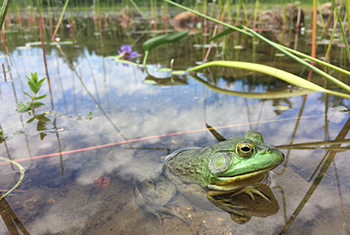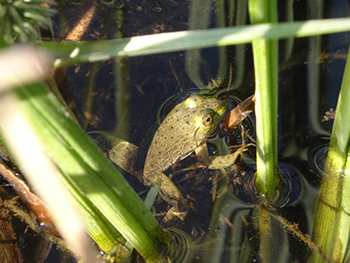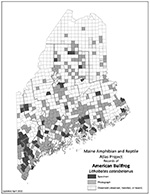Home → Fish & Wildlife → Wildlife → Species Information → Reptiles & Amphibians → American Bullfrog
American Bullfrog
Lithobates catesbeianus
On this page:

Photo: Trevor Persons
Distinguishing Characteristics
- The largest North American frog, up to approximately 8 inches in length
- Light green, olive, dark green, or brown above, underside creamy white, throat often yellow
- No ridges (dorsolateral folds) along sides of back; raised ridge instead curves from behind eye over and around eardrum
- Commonly confused with green frog
- Breeding call is a low-pitched, repeated “rum”
Status and Distribution in Maine
- Common and secure
- Statewide
Habitat

Photo: Trevor Persons
- Highly aquatic, uses permanent streams, slow rivers, ponds, and shallow bays of lakes
Diet
- Aggressive predator, eats anything it can catch including invertebrates, fish, snakes, or frogs (including other bullfrogs)
Seasonal Changes
- Hibernates in mud at the bottom of ponds or streams
Natural History Notes
- Requires permanent water for tadpoles, which typically take two years to develop
- In some areas, bullfrogs are harvested for their edible legs
- Breeds later than most other frogs in Maine, when air temperatures are above 68°F, typically mid-June to July
Share Your Sighting
There is much still to learn about the distribution and ecology of Maine’s herpetofauna, and we encourage members of the public to share their photo-documented observations as part of the Maine Amphibian & Reptile Atlas Project (MARAP).
To see if a township still needs documentation of a species, consult this distribution map (PDF). If a township lacks a photo or specimen record, we want your observation!
There are two ways to share your observations:
Submit your reptile or amphibian observation online
No service? No problem. Click here to download the survey to your device while connected, then take offline to collect observations from anywhere. Tip: The survey works best on Google Chrome and Safari.
Or upload sightings to the iNaturalist community science project through their website at iNaturalist.org or mobile app.
- When submitting an observation through iNaturalist add a description of the location (and other noteworthy information) to the “notes” field. This serves as a check on the locations automatically generated by smartphone cameras, which may be imprecise if cell service or GPS coverage is weak.
Thank you for doing your part to help conserve Maine’s reptiles and amphibians.
